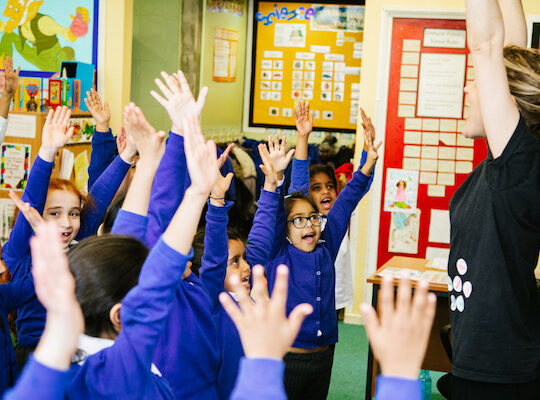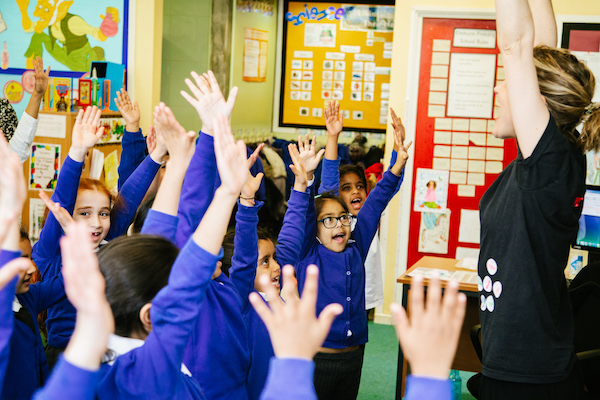How to teach maths creatively

How to teach maths creatively
But mathematics isn’t just a useful science. It is itself a very creative subject, and it can be taught as playfully as the arts.
Marcus du Sautoy

At Artis, our work in schools is not about polarising the arts from maths, or science or literacy or topic work. Artis sessions are about teaching curriculum subjects through music, drama and movement. It is about utilising the arts as a tool for learning. By bringing a topic to life you are helping children access knowledge in an active and responsive way.
Here we discuss how we teach maths creatively and offer creative maths resources.
We sing about punctuation, act out fractions and dance the solar system.
Artis pride ourselves on the imaginative ways that we can find to teach subjects that are traditionally “non-creative”. We wanted to bring together some links to resources that help children teach maths creatively:
Why teach maths creatively?
Builds confidence and curiosity
Many children find maths intimidating, especially when taught in rigid, abstract ways. A creative approach—using games, storytelling, and hands-on activities—helps break down barriers and builds confidence. It encourages children to ask questions, explore ideas, and see mistakes as part of the learning process.
Makes learning more inclusive
Creative maths teaching supports different learning styles, whether visual, auditory, or kinaesthetic. It gives all pupils, including those who struggle with traditional methods, a chance to engage and succeed. This helps close attainment gaps and ensures everyone has a fair shot at enjoying and understanding maths.
Connects maths to real life
Bringing creativity into maths links numbers to everyday experiences—cooking, nature, architecture, music. This shows students that maths isn’t just something to be memorised for tests; it’s a powerful tool that helps explain the world around them.
Encourages problem-solving and resilience
Creative approaches often involve open-ended challenges, collaboration, and experimentation. These build critical thinking, communication skills, and perseverance—abilities that go well beyond the classroom.
Are schools teaching maths in the best way?
Many children struggle with maths not because they lack ability, but because of how it’s often taught. Traditional maths education tends to focus on rote learning, speed, and getting the ‘right’ answer. This approach can feel rigid, stressful, and disconnected from real life.
When maths is reduced to memorising formulas or following fixed steps, it leaves little room for exploration or understanding. Pupils who don’t immediately ‘get it’ can quickly lose confidence, labelling themselves as ‘bad at maths’. Once that belief sets in, it becomes a barrier to progress.
In many classrooms, success in maths is measured by speed, who can solve it first, rather than depth of thought or creativity. This pressures some students while leaving others behind. It doesn’t reflect how mathematical thinking actually works in the real world, where taking time to understand, test ideas, and solve problems is far more valuable.
The lack of context is another issue. Without real-life links, maths can feel pointless or abstract. Children need to see how it applies to things they care about like building, budgeting, music, or nature to stay engaged.
In short, it’s not children who are the problem – it’s the way maths is often taught. A more creative, flexible, and inclusive approach can change that.
Creative maths resources
- Video Resource – Body Countdown : Body countdown can be used as warm up before physical activity and is an active way of practising countdown, subtraction and developing coordination. Body countdown can be easily adapted for KS1 or KS2 children and to different levels of ability.
- Video Resources : Squares and Circles : The perfect maths activity for LKS2. With a geometry focus on circles and squares.
- Video Resources : Pulse Warm Up : A warm up, or refocus activity, to encourage children to work as a team and develop their pulse and rhythm skills. Numeracy skills are also encouraged with the counting of the rhythm and can be further developed to include adding and subtraction.
- Teaching Resource – Be Maths Smart : Be Maths SmART is a blog designed to provide inspiration & ideas for teaching maths through the performing arts.
- Teaching Resource – Top 10 Tips for Maths through the Arts : Finding practical applications for maths, is key to understanding the importance and relevance of the subject, and enthusing your students. In fact, when you start looking for Maths in everyday life, and in other subjects, you find it everywhere.A cross curricular approach greatly helps to deepen children’s understanding, and strengthen their learning. Additionally, it gives the children’s confidence and enthusiasm for maths a huge lift, as it gives those who don’t excel in more traditional lessons a real opportunity to shine.
- Blog : Can children take their first steps in mathematics through the performing arts? Our schools tell you how their children are able to excel in maths through their Artis sessions.
- Blog : A-one, two, three FOUR! Maths and music have a lot more in common than you think. This blog explores patterns and counting in music.
- Blog : Telling Stories with Mathematics by Marcus du Sautoy. A brilliant blog by mathematician Marcus du Sautoy about how maths is actually inherently creative.
There are so many incredible benefits to using the arts in the classroom, including physical and mental wellbeing, but there are also so many benefits to reading and writing, to understanding, to spatial awareness and communication. Numeracy is an integral skill in life, but so is creativity, and we believe there are so many ways that you can foster both inside and outside of the classroom.
Artis offer CPD days for teachers interested in learning more about teaching maths creatively, so if you would be interested in finding out more, please contact us here. We also run Project Days and Arts Weeks with maths as a focus area.

